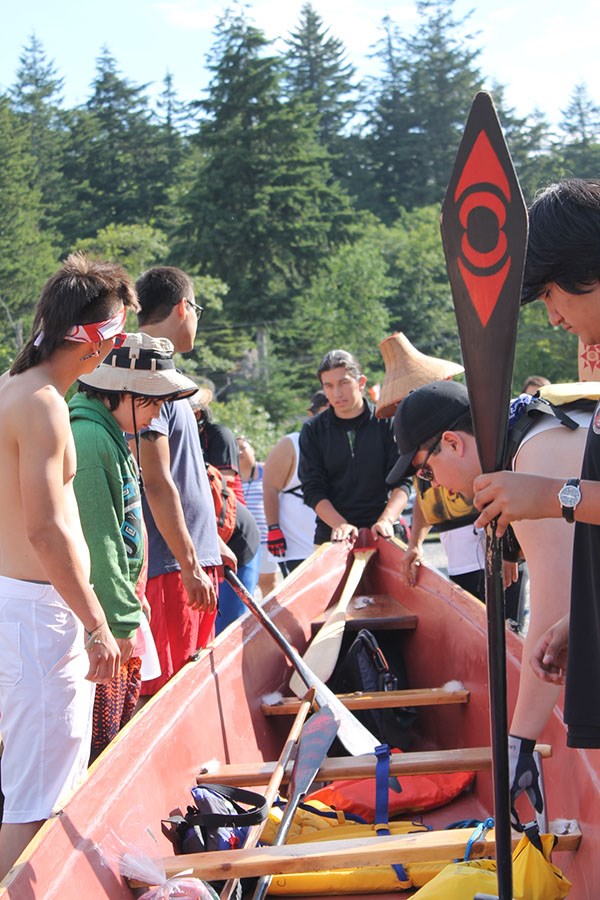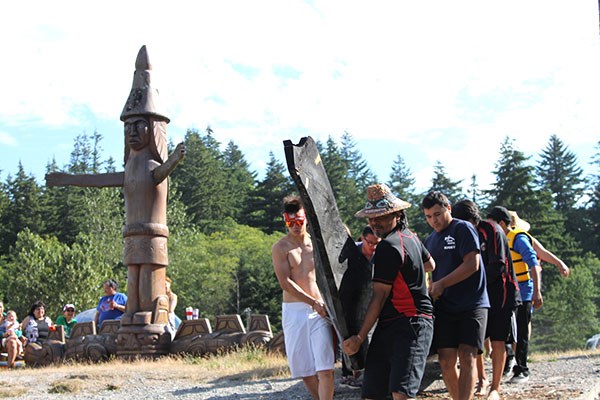Members of the þ£ƒÃ…Á«¯Nation departed under sunny skies, backed by a supportive farewell from family and friends from Stawamus Village last week.
On Thursday (June 26) at 10 a.m, two traditional cedar dugout canoes left from the Stawamus waterfront adjacent to the log sort. Their final destination after an eight-day journey up the coast is Tribal Journeys — the Qatuwas Festival in Bella Bella.
Sixteen pullers (or paddlers) sorted gear, talked over the day’s plan, launched their canoes and left the Mamquam Blind Channel with an escort from the RCMP. A ground crew of 19 is going by van and will meet with the canoes along the way.
The group‚Äôs first planned stop was the Chekwelp Indian Reserve near Gibsons, about a three-hour paddle from Squamish. On Friday (June 27), they planned to cross the Salish Sea to Newcastle Island off Nanaimo, where they were to rendezvous with more canoe families and then continue on.¬Ý
Some 5,000 people in more than 100 traditional dugouts are expected at this year’s Qatuwas festival in Bella Bella. The groups will feast, dance, sing and share stories and customs with one another. The groups are coming from all along the coast, some as far south as Oregon.
Long ocean travel by cedar dugouts is a tradition that was dormant for decades. The culture was reignited when members of the Heiltsuk Nation paddled from Bella Bella to Expo ‘86 in Vancouver, a 500-kilometre journey.
The þ£ƒÃ…Á«¯Nation became involved in 1993 when they responded to the challenge by the Heiltsuk people to build traditional canoes and travel north to Bella Bella. The boats were the first sea-going canoes carved by the þ£ƒÃ…Á«¯people in more than 100 years.
Since then, the þ£ƒÃ…Á«¯people have built more traditional canoes, now totalling 10. Ray Natraoro carved the two canoes that left from þ£ƒÃ…Á«¯on Thursday. One was completed in 2010 and the other last weekend in preparation for this year‚Äôs journey.
Dustin Khelsilem, a student of Natraoro, is overseeing much of the organization required for the trip and is the skipper of one of the canoes. He said the trek is something he grew up watching other people do and now he is happy to be participating himself.
“It’s a good way to bring back a culture and our traditions and old customs: going up the coast and stopping at all the different villages and going back to those ways of sharing each other’s songs and dances,” said Joyce Williams, who has done the trip four times previously.
Williams is bringing along her daughter, Anna-lee, for the first time.
“For me, I’m almost more excited for my daughter,” Joyce Williams said. “It will be really good for them (children) to start seeing those traditions and customs at such a young age.”
The Tribal Journeys Qatuwas Festival runs from July 13 to 19. Afterwards, the participants from þ£ƒÃ…Á«¯Nation will return home by vehicle.
This year, information about the journey (routes and updates from different groups) is accessible on a mobile app from: onefeather.ca. There is also a Twitter conversation (#FollowTheJourney) where participants and observers can correspond.





